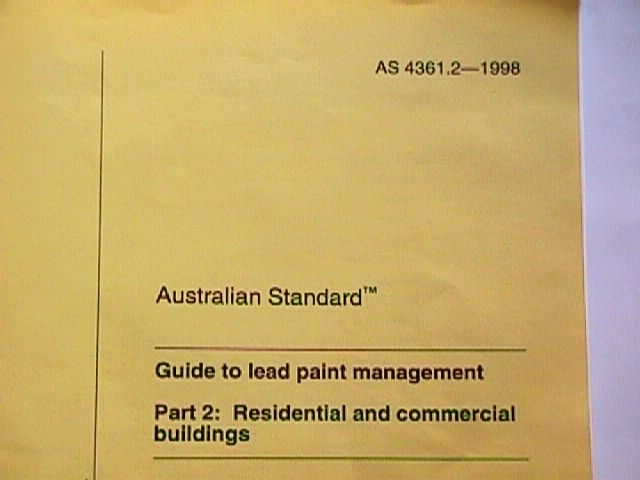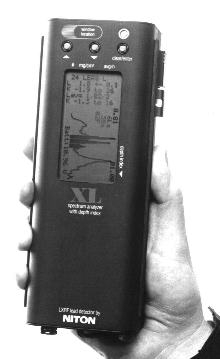|
||||||||||||||||||||
| Australian Standard 4361.2 Guide To Lead Paint Management Preventing Lead Poisoning in Australia | ||||||||||||||||||||
|
About Us Visitor
Number Total Page Views To |
Architects, project managers and specification writers are becoming part of Australia's first line of defence in protecting the community against the dangers of lead. This unusual partnership is a direct result of the efforts of a Committee set up by Standards Australia on Paint and Related Materials . The outcome of the Committee’s work was Australian Standard (AS) 4361.2 Guide to Lead Paint Management; Part 2 Residential and Commercial Buildings, published in May 1998. This Standard compliments AS 4361.1 for industrial applications. The new Standard will assist a range of building professionals from architects to contractors manage lead hazards on-site and will also reduce their risk of litigation due to a poisoning of workers or occupants from lead. SUMMARY There are over 3.5 million homes built before 1970 in Australia, MOST OF WHICH contain lead paint. Renovations of these buildings place the health of many people at risk including:
In recent decades, the majority of children admitted to hospitals with lead poisoning were as a result of unsafe home renovation and maintenance activities. The primary cause of lead hazards arising from renovation of pre-1970 buildings is the presence of old lead paint and lead contaminated dust. In-situ dust can be disturbed during work activities or new dust can be generated by disturbing old lead paint. Dust can contaminate work areas or, if uncontained, adjacent areas and neighbouring properties. Surface dust lead loadings in typical uncontrolled renovations have been shown to reach 200 milligrams / m2 on floors compared to an "acceptable level" of one milligram/ m2. Until now, building professionals have had no uniform standard to manage lead hazards in commercial and domestic situations. The new AS will assist architects, project managers and contractors to identify and effectively manage hazards. Using the management practices specified in AS 4361.2 acceptable levels can be met (and even exceeded).
Effective lead hazard management programs include the following : 1. Testing Testing is essential to identify any potential problems and determine what management decisions must be made. Testing can indicate where lead is located and also importantly where it is not. Paint lead levels greater than 1.0 milligram lead per square centimetre of surface area or 1.0 percent lead by weight require management. Detection can be achieved in one of three ways:
The price of testing can range from a few hundred dollars to test a block of flats or a day care centre to a few thousand dollars to test a large school. (see CONTACT LIST following) 2. Specification Specifications provide a clear path and direction for project managers and tradespeople. Similar to all other specifications this Australian Standard can be tailored to any job or activity. The use of AS 4361.2 - 1998 provides the user with knowledge, options and methods. It also makes it clear that in addition to the "normal" performance standards, a Clearance Standard has been established. The use of this specification will ensure that the area is left free of lead hazards. (see CONTACT LIST) 3. Management options.
4. Contractor selection Using the right person for the right job or activity has never been truer than now. Lead trained people are a key element to overall success. Co-operation between the professional trades associations, TAFE and The Lead Reference Centre, NSW EPA, is leading to significant educational advancements in the trades. Architects can further the process by ensuring that only those trained in lead remediation, work with lead paint. (see CONTACT LIST) 5. Clean-up and clearance testing If lead hazards have been effectively managed, clean up of the work area can be as simple as using high efficiency particulate air (HEPA) industrial vacuum cleaners and wet cleaning. These two basic techniques properly used together will remove lead dust hazards . Clearance testing is the final step and is used to "release" the work area back to the Property Owner. Testing involves the sampling of soil and surface dust to determine if there has been a significant impact on the property and surrounding areas from the work This process of testing provides an assurance to the owner, architect, and contractors that the work has left the area free of lead hazards. While test results provide an assurance, architects should require their Lead Assessor to provide insurance in the form of Professional Indemnity. This risk coverage may protect the architect from claims down the track. Experienced lead assessors should be used to do clearance testing and a written report provided.
Where do I get assistance? The new Standard is a valuable tool to assist building professionals to manage lead hazards. There is a need for it’s wide use and incorporation into project design and management systems. Currently there is no centralised list of lead trained tradespeople, assessors and remediators. However, there are professionals out there and the Lead Advisory Service contact list will help you find them.
Written by Michelle CALVERT, Education Officer of
The Lead Advisory Service (NSW). |
|||||||||||||||||||
|
About
Us |
bell
system lead poisoning |
Contact Us
| Council
LEAD Project | egroups | Library
- Fact Sheets | Home
Page | Media Releases |
||||||||||||||||||||
|
Last
Updated 19 September 2013
|
||||||||||||||||||||



